Solar capacity expansion in Asia was 237.7 GW in 2023, more than double from 2022 figures, with 91.2% of the solar expansion occurring in China and India, says the report
In 2023, Asia accounted for the majority of new RE capacity, about 69.3%, increasing the region’s renewable capacity by 327.8 GW to reach 50% of the global total. The majority of this increase occurred in China (+297.6 GW), according to a new report by the International Renewable Energy Agency (IRENA).
Solar energy led the expansion in Asia by adding 237.7 GW in 2023 (compared to +110.7 GW in 2022). Again, 91.2% of the expansion occurred in China (+216.9 GW) and India (+9.7 GW), the Renewable Capacity Statistics 2024 mentioned.
Globally, the report said that at the end of 2023, global renewable power capacity amounted to 3,870 GW, with solar accounting for the largest share of the global total. The world also saw a 13.9% growth in renewable capacity during 2023.
The report revealed the renewable power generation capacity statistics for the past decade (2013-2023). The analysis said that there was a 473 GW net increase in global renewable power capacity in 2023. Renewable power generation capacity is measured as the maximum net generating capacity of power plants and other installations that use renewable energy sources to produce electricity.
Europe and North America also saw capacity expansion by 71.2 GW and 34.9 GW respectively, while Africa continued to grow steadily with an increase of 2.7 GW. Oceania’s installed capacity increased by 5.5 GW, largely due to Australia, and South America continued on an upward trend, with a capacity expansion of 22.4 GW. The Middle East also recorded its highest expansion on record, with 5.1 GW of new capacity commissioned in 2023, the report found.
G7 and G20
According to the report, the G7 countries (excluding the EU) comprised 25.3% of the global capacity share with a total of 980 GW. The G20 countries (excluding the EU and AU) account for 79.7% of the global share with a total capacity of 3,084 GW. The G7 and G20 countries respectively account for 14.7% and 87.2% of new capacity in 2023.
Trends in RE tech
Looking at the various renewable energy technologies across the world, the report found that solar photovoltaic power accounted for almost all the increase in solar power in 2023, with an increase in solar PV of 345.5 GW and an increase of 0.3 GW in concentrated solar power.
On the other hand, renewable hydropower expanded at a lower level in recent years with an increase in capacity of 7 GW. The largest capacity increase occurred in China.
Lagging so far, wind power, with an increase of 116.0 GW in 2023, has seen its biggest increase in the past decade. China accounted for almost two-third of this expansion (+75.9 GW) and capacity in the United States increased by 6.3 GW. Most of the remaining capacity expansion occurred in Brazil, India, Canada and a handful of European countries.
While bioenergy capacity expansion slowed down in 2023, Geothermal capacity increased marginally in 2023.
RE capacity expansion
In 2023, renewable power capacity expansion increased compared to 2022 and stayed well above the long-term trend. As in previous years, most of this expansion occurred in China and, to a lesser extent, the United States. However, most other countries also increased their expansion of renewable capacity in 2023 compared to 2022. The share of renewables in total capacity expansion reached 86% in 2023, compared to the figure of 84% in 2022.
The renewable share of total power capacity also rose by almost three percentage points from 40.4% in 2022 to 43.2% in 2023. The upward trend in these shares continues to show both the rapid and increasing growth in the use of renewables and the declining expansion of non-renewable capacity. At the global level, the latter is partly due to the large amount of net decommissioning that has occurred for many years in some regions. However, more still needs to be done to achieve the goal adopted at COP28 to triple installed renewable power capacity by 2030 to reach 11 TW.
About The Author
You may also like
India’s EV revolution: Are e-rickshaws leading the charge or stalling it?
India’s solar output grows at slowest pace in six years in first half of 2024
India to bear the highest cost globally as climate change increases women’s water collection burden
India’s solar expansion threatened by transformer shortage
Air pollution leading risk factor for death in South Asia, killed 2.6 million in 2021: Report


